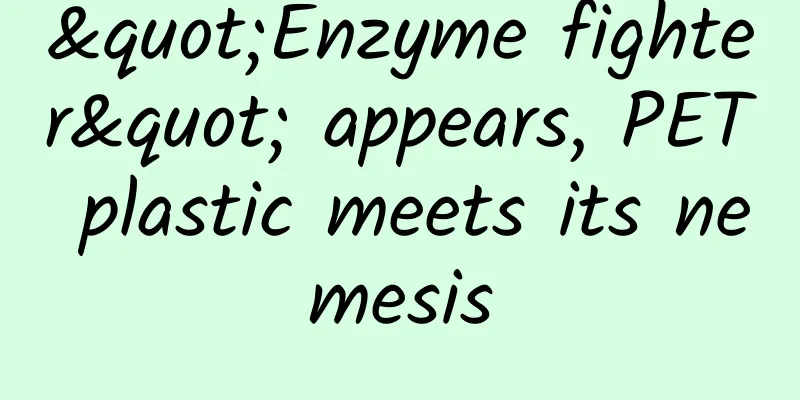"Enzyme fighter" appears, PET plastic meets its nemesis

|
While plastics bring convenience to humans, they also lead to the emergence of a large amount of white waste. Their degradation rate in nature is often calculated in centuries. However, in a new study published in Nature, researchers used an AI machine learning system to develop a new PET plastic (polyethylene terephthalate) hydrolase that can degrade more than 50 types of PET plastics without pretreatment within 1 week. Within 48 hours, FAST-PETase completely degrades PET plastic containers Image source: Reference 1 What is so great about this enzyme? How does AI assist in the development of enzymes? Part 1 Enzymes, the magicians of biochemical reactions We have learned from high school textbooks that enzymes are certain special proteins (a very small number are RNA) produced by living cells. They participate in a series of biochemical reactions in the body and regulate the rate, direction and degree of the reactions through complex and sophisticated mechanisms. They can be called magicians in the body. However, the environment in which enzymes work is no longer limited to living organisms. In the modern industrial system, we can artificially prepare biological enzymes and use them in detergents, crude oil pollution treatment, biomass fuel preparation, killing harmful bacteria, etc. The newly upgraded PET hydrolase is one of the latest artificial enzymes developed by humans. We have mentioned that the essence of enzymes is biological macromolecules such as proteins. So what kind of substance is protein and how do they participate in chemical reactions? The building blocks of proteins are amino acids, which have a very simple structure. The center of the amino acid structure is a carbon atom, which is connected to an amino group (-NH2, called the N-terminus) on one side and a carboxyl group (-COOH, called the C-terminus) on the other side. The side chain group R connected to the carbon atom will vary depending on the type of amino acid. First, the amino group of an amino acid and the carboxyl group of another amino acid can undergo a dehydration condensation reaction to form a -CO-NH- connection, which is a peptide bond. In reality, proteins are composed of a series of amino acids polymerized through peptide bonds to form a long chain structure. Schematic diagram of the dehydration condensation of two amino acids Image source: wikipedia However, this series of amino acids is by no means arranged in a straight line, but will spontaneously form a certain spatial structure, just like a piece of wool wound into a ball. The most amazing thing is that the "ball" formed by this long chain of amino acids is not formed by random "entanglement". Once the amino acid sequence that makes up the protein is determined, their "entanglement" method will also be determined. This is the so-called "protein folding". The quaternary structure of a protein (left) and the diverse proteins in the Protein Database (right) Image source: OpenStax College The key to enabling proteins to exert their physiological activity is their special spatial structure. Once this spatial structure is destroyed (such as a boiled egg), even if the amino acid sequence that makes up the protein does not change, the physiological functions that the protein can perform will be weakened, inactivated, or even out of control. The essence of proteins performing physiological functions is to participate in various chemical reactions. Their complex diversity means that there are infinite possibilities for the reactions they can participate in. Enzymes, as special proteins, play a huge role in regulating biochemical reactions. They often act as catalysts. In the presence of enzymes, the rate of biochemical reactions can be increased by hundreds of millions of times. Part 2 The best enzyme in the world: PET-degrading enzyme The total amount of PET produced and consumed worldwide each year accounts for one-sixth of the world's total plastic consumption, about 100 million tons, and most transparent beverage bottles are made of PET. Although PET is one of the most recycled plastics, less than half of PET products are ultimately recycled. Since the chemical bonds between monomers in polymers such as PET are difficult to break by ordinary means, in the ordinary plastic recycling process, only the raw materials can be downgraded and reused. For example, food-grade PET plastic bottles are recycled and heated to dissolve into PET particles, which are then heat-processed again to make PET fibers, which are then used to make plastic ropes or plastic bags. However, PET degrading enzymes can directly break the chemical bonds in this polymer and reduce it to terephthalic acid and ethylene glycol, which have little impact on the environment. The classic route for PET recycling: classification - crushing - powder making - chemical fiber - environmentally friendly woven bags Image source: Reference 3 The latest achievement published in Nature magazine is essentially to use deep learning to modify the structure of PET degrading enzyme, which promotes the process of this technology towards practical application. Let's first understand this modification method and then introduce the principle of deep learning. A single enzyme molecule is like a carefully assembled machine. The sequence and spatial structure of amino acids are its assembly method. If the assembly method is incorrect, the machine will not function properly even if all the parts are intact. Under normal circumstances, enzymes have an activity condition. Most enzymes act in living organisms, so their activity temperature range is generally near the living temperature of the organisms, and there are certain requirements for pH values. If we want to use enzymes to regulate reactions in an environment outside the human body, the various changes in conditions we face will be much more complicated. Especially in application scenarios such as plastic degradation, the reaction conditions are almost completely uncontrollable. It is very likely that the enzyme that can normally degrade plastic in a laboratory beaker will not be able to exert its power in the natural seabed mud or landfill. So, how should we solve this problem? Left: PET film surface with PET-degrading bacteria attached, right: (partial) pitting surface after decomposition, upper right small picture: film surface before decomposition Image source: Reference 4 The paper reported in Nature magazine shows that after replacing the amino acids at five sites on the natural PET hydrolase, the researchers obtained a mutant PET hydrolase FAST-PETase. Compared with the natural PET hydrolase and other industrial enzymes, this enzyme has a strong ability and stability to degrade PET, and can work at 30-50℃ and a certain pH range. This study clearly tells us that the method of modifying the structure of biological enzymes to enhance their activity can also be applied to PET-degrading enzymes. You should know that the activity of oil-decomposing enzymes in laundry detergent and catalytic enzymes in the biomass fuel manufacturing process has increased nearly a thousand times in more than ten years. PET degrading enzyme decomposition route Image source: Reference 4 However, modifying the structure of an enzyme is easy to say, but when faced with such a complex macromolecule with thousands of amino acids, where should we start with our modification? Part 3 Artificial intelligence that "creates" PET-degrading enzyme Perhaps you have heard such a metaphor when you were very young: the computer is stupid and can only count beans, but it counts very quickly and can count hundreds of millions of beans in the blink of an eye. This example vividly illustrates the two main characteristics of computers when performing specific work. The first is strong computing power (fast counting), and the second is that there are specific algorithms for handling specific tasks (for example, counting beans is the enumeration method). The computing power of current home computers is amazing. If you really need to process massive amounts of data and complex systems, there are options with more powerful computing power, such as workstations or supercomputers. Therefore, computing power is not a major obstacle for humans. The key that bothers us is the algorithm, that is, how to solve complex problems in the most efficient way. The so-called artificial intelligence is a collection of such algorithms. Taking the most popular machine learning (which can be considered as a means of implementing artificial intelligence) as an example, its general idea and principle is to first input a series of existing data (such as Go chess records) into the computer, and then use a special algorithm model (such as a neural network) to let the computer analyze and integrate this data. After that, the computer will learn like a human, looking for patterns from these data, using its own computing power to conduct massive trial and error (such as Go AI), and select the best result. When this learning and training process is completed, the entire AI will evolve and have the ability to solve related problems. Advanced artificial intelligence algorithms even allow computers to master relevant skills with only a small number of learning samples. For example, in the development process of Go AI, the step of inputting chess records is omitted, and only the relevant rules of Go are told to the computer. The computer will then use the corresponding algorithm to self-explore and self-train these rules. When the training is completed, it will have the ability to compete with top human players. As for the time required for training and the final learning effect, it is determined by the configuration of the computer and the rationality and effectiveness of the specific algorithm. Taking this study as an example, scientists input part of the data obtained in the experiment into the computer, and the computer can optimize the structure of the enzyme based on this data. In this way, based on a small amount of data, the screening results that can only be achieved through enumeration in traditional methods can be obtained, and subsequent experimental verification will be much easier. Animation: Comparison between the protein structure predicted by AlphaFold (blue) and the actual structure (green). Source: AlphaFold Part 4 PET-degrading enzymes still need further evaluation As the name suggests, the PET degrading enzyme currently developed is specifically used to degrade PET. However, PET is not the only type of plastic. We can easily name a long list: PE (polyethylene), PVC (polyvinyl chloride), PI (polyimide), PF (phenolic resin), Teflon (polytetrafluoroethylene), ABS resin (acrylonitrile-butadiene-styrene copolymer)... The monomers, polymerization methods, degree of polymerization and molecular weight of these polymer materials are all different. The degrading enzyme suitable for PET cannot decompose other types of plastics. In addition, some scientists have suggested that a systematic assessment should be conducted on the entire life cycle of this new treatment method to determine whether greenhouse gas emissions are within an acceptable range during the process of cultivating bacteria and bacterial decomposition of plastics. If, during this cycle, greenhouse gas emissions approach those from the oil industry's plastic manufacturing process, the attractiveness of plastic-degrading enzymes will undoubtedly be greatly reduced. Therefore, at this stage, strictly controlling the use of plastic products and standardizing their disposal is the realistic option to improve the utilization efficiency of related materials and reduce environmental pressure. References: 1.Machine learning-aided engineering of hydrolases for PET depolymerization https://www.nature.com/articles/s41586-022-04599-z 2.Scientists accidentally create mutant enzyme that eats plastic bottles https://www.theguardian.com/environment/2018/apr/16/scientists-accidentally-create-mutant-enzyme-that-eats-plastic-bottles 3.A bacterium that degrades and assimilates poly(ethylene terephthalate) https://www.science.org/doi/10.1126/science.aad6359 4.Discovery of a Bacterium that Degrades and Assimilates Poly(ethylene terephthalate) could Serve as a Degradation and/or Fermentation Platform for Biological Recycling of PET Waste Products https://www.keio.ac.jp/en/press_releases/2016/cb96u90000005501-att/160330_2.pdf Produced by: Science Popularization China Author: iFrec Lu Xiuyuan Producer: China Science Expo The article only represents the author's views and does not represent the position of China Science Expo This article was first published in China Science Expo (kepubolan) Please indicate the source of the public account when reprinting Please indicate the source of the reprint. Reprinting without authorization is prohibited. For reprint authorization, cooperation, and submission matters, please contact [email protected] |
Recommend
Whoosh~Eeh? They seemed to smell the "smell" of the universe...
The universe, this mysterious and vast space, alw...
Are there auroras on the sun?
Hello everyone, my name is Zhou Xuzhi, from the I...
If you have posted these five types of photos, please delete them immediately!
Recently, the topic **#Don't post 5 kinds of ...
BYD released the Honor Edition Han Tang, and taught Xiaomi how to build cars. The industry officially entered the knockout round
Just after the Spring Festival, BYD dropped a bom...
Toyota invests 19 billion to establish a new company and will let driverless cars drive on the highway in two years
Tesla and Internet companies such as Google are n...
User system construction: analysis of user grouping methodology!
During this period, Tik Tok has become popular an...
Chevrolet Bolt officially goes into mass production, Model 3 can stand aside
For those who like entry-level electric cars, the...
What do you get if you draw a hexagon on the sea? This "national project" is extraordinary!
What do you get if you draw a hexagon on the sea?...
Weekly Science | Answers to common questions from parents about children's vision protection
Myopia prevention and control Recently, we have s...
Creating QR codes using Google's Web API
Google Charts can be queried via POST (see here f...
How to get users to try your new product? Here are 5 tips!
A while ago, a new coffee shop opened downstairs ...
Luo Yonghao, the founder of Smartisan: "Slapping people in the face" is part of my job
"I particularly dislike the practice of some...
Analysis of the growth model of the "Get" APP
An article explains the AARRR, HOOK model and oth...
24 articles to help you count down the 24 hours until National Day
The eight-day National Day holiday is coming soon...
How much does a POS machine cost? (How to apply for a POS machine? Is there any fee?)
What should you do when you urgently need to appl...









